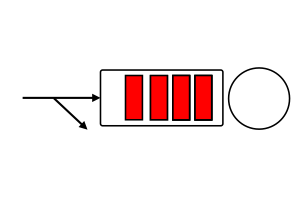
Solutions to Queueing Systems
Simple and computationally efficient solutions for the evaluation of the steady-state queue length distribution.
This site presents some of our work related to the numerical analysis of queueing systems. We provide the solution for some classical models of queues.

The G/M/c-like queue
The solution to this queue with multiple servers is fast, based on a simple recurrence and numerically stable.
- Solve the G/M/c queue
- For more information: [1]
The M/G/1-like queue
The solution to this classical queue is fast, based on a simple recurrence and numerically stable.
- Solve the M/G/1 queue
- For more information: [3]
The M/G/c-like queue (New)
The solution to this classical queue is based on a simple yet accurate approximation using a reduced-state description.
- Solve the M/G/c queue
- For more information: [4]
The G/G/c-like queue (Beta version)
The solution to this classical queue is found using the solutions of two simpler models, i.e. M/G/c-like and G/M/c-like queues.
- Solve the G/G/c queue
- For more information: [5]
 We are working
to include more models
We are working
to include more models 
Associated publications
- [1] A Recurrent Solution of Ph/M/c/N-like and Ph/M/c-like Queues. A. Brandwajn, T. Begin – Journal of Applied Probability, Volume 49, Number 1, Pages 84-99.
- [2] A tool for solving Ph/M/c and Ph/M/c/N queues. T. Begin, A. Brandwajn, – Proceedings of the 9th ACM International Conference on Quantitative Evaluation of SysTems, QEST12.
- [3] A conditional probability approach to M/G/1-like queues. A. Brandwajn, H. Wang – Performance Evaluation, Volume 65, Issue 5, 2008, Pages 386-405.
- [4] Reduced complexity in M/Ph/c/N queues. A. Brandwajn, T. Begin – Performance Evaluation, Volume 78, 2014, Pages 42-54.
- [5] Reducing the complexity of performance analysis of a multi-server facilities. T. Atmaca, T. Begin, A. Brandwajn, H. Castel – Technical Report, 2014.
Compatible browsers
This site is compatible with the following browsers:
- Google Chrome
- Internet Explorer 9.0
- Safari 5
- Firefox 3.x, 4.x and 7.x
If you use IE 8.0, the steady-state distribution for the number of customers in the system will not be displayed as a plot, but instead as a table since svg format is not supported.
Acknowledgement
Many thanks to Dominique Ponsard and Lucas Delobelle for their help.
Authors
Last update: January 2015